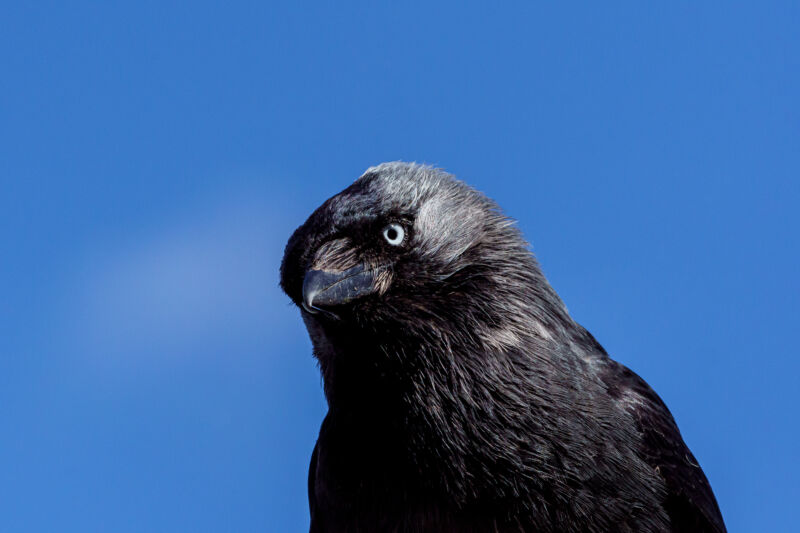Working on memory —
Birds show evidence that they lump temporary memories into categories.

Enlarge / A jackdaw tries to remember what color it was thinking of.
Humans tend to think that we are the most intelligent life-forms on Earth, and that we’re largely followed by our close relatives such as chimps and gorillas. But there are some areas of cognition in which homo sapiens and other primates are not unmatched. What other animal’s brain could possibly operate at a human’s level, at least when it comes to one function? Birds—again.
This is far from the first time that bird species such as corvids and parrots have shown that they can think like us in certain ways. Jackdaws are clever corvids that belong to the same family as crows and ravens. After putting a pair of them to the test, an international team of researchers saw that the birds’ working memory operates the same way as that of humans and higher primates. All of these species use what’s termed “attractor dynamics,” where they organize information into specific categories.
Unfortunately for them, that means they also make the same mistakes we do. “Jackdaws (Corvus monedula) have similar behavioral biases as humans; memories are less precise and more biased as memory demands increase,” the researchers said in a study recently published in Communications Biology.
Remembering not to forget
Working memory is where we hang on to items for a brief period of time—like a postal code looked up in one browser tab and typed into a second. It can hold everything from numbers and words to images and concepts. But these memories deteriorate quickly, and the capacity is limited—the more things we try to remember, the less likely the brain is going to remember them all correctly.
Attractor dynamics give the brain an assist with working memory by taking sensory input, such as color, and categorizing it. The highly specific red shade “Fire Lily” might fade from working memory quickly, and fewer specifics will stick around as time passes, yet it will still be remembered as “red.” You lose specifics first, but hang on to the general idea longer.
Aside from time, the other thing that kills working memory is distractions. Less noise—meaning distracting factors inside and outside the brain—will make it easier to distinguish Fire Lily among the other reds. If a hypothetical customer was browsing paint swatches for Sandstone (a taupe) and London Fog (a gray) in addition to Fire Lily, remembering each color accurately would become even more difficult because of the increased demands on working memory.
Bias can also blur working memory and cause the brain to remember some red hues more accurately than others, especially if the brain compartmentalizes them all under “red.” This can happen when a particular customer has a certain idea of the color red that leans warmer or cooler than Fire Lily. If they view red as leaning slightly warmer than Fire Lily, they might believe a different, warmer red is Fire Lily.
In living color
To find out if corvids process stimuli using short-term memory with attractor dynamics, the researchers subjected two jackdaws to a variety of tests that involved remembering colors. Each bird had to peck on a white button to begin the test. They were then shown a color—the target color—before being shown a chart of 64 colors. The jackdaws had to look at that chart and peck the color they had previously been shown. A correct answer would get them their favorite treat, while responses that were close but not completely accurate would get them other treats.
While the birds performed well with just one color, their accuracy went down as the researchers challenged them to remember more target colors from the chart at once. They were more likely to pick colors that were close to, but not exactly, the target colors they had been shown—likely because there was a greater load on their short-term memory.
This is what we’d see if a customer had to remember not only Fire Lily, but Sandstone and London Fog. The only difference is that we humans would be able to read the color names, and the jackdaws only found out they were wrong when they didn’t get their favorite treat.
“Despite vastly different visual systems and brain organizations, corvids and primates show similar attractor dynamics, which can mitigate noise in visual working memory representations,” the researchers said in the same study.
How and why birds evolved attractor dynamics still needs to be understood. Because avian eyesight differs from human eyesight, there could have been differences in color perception that the research team was unable to account for. However, it seems that the same mechanisms for working memory that evolved in humans and other primates also evolved separately in corvids. “Birdbrain” should be taken as a compliment.
Communications Biology, 2023. DOI: 10.1038/s42003-023-05442-5